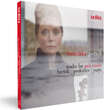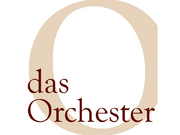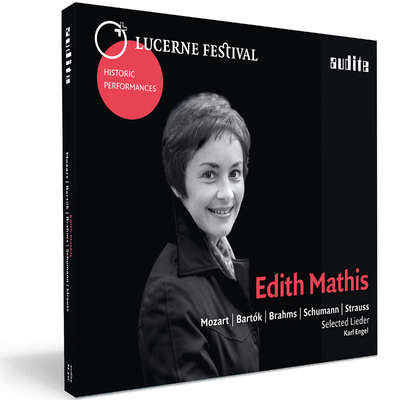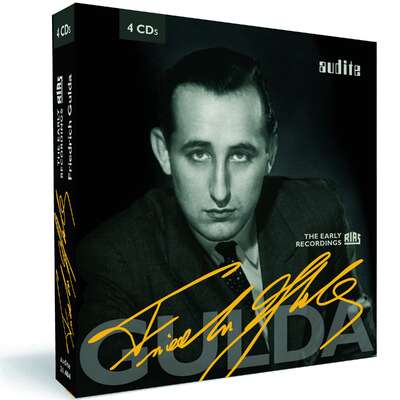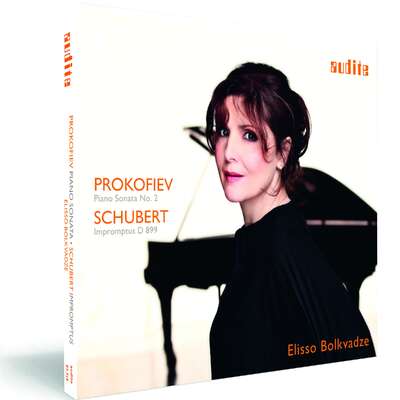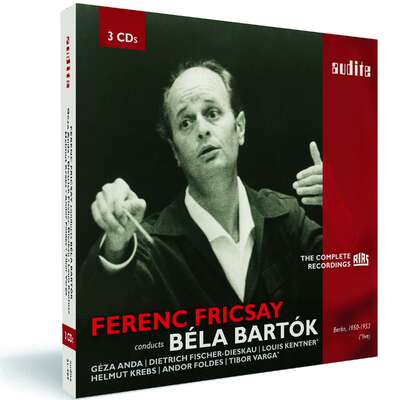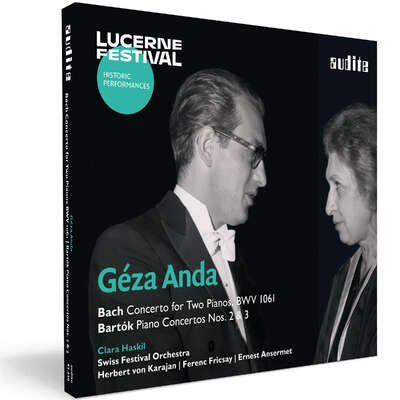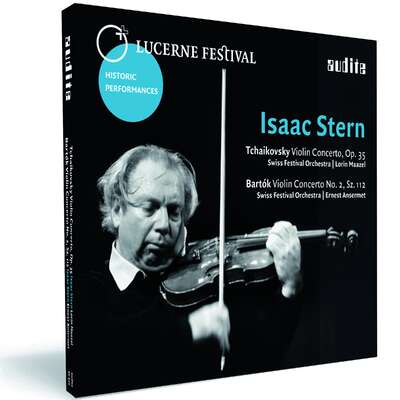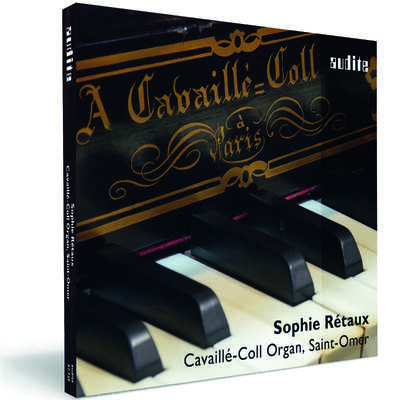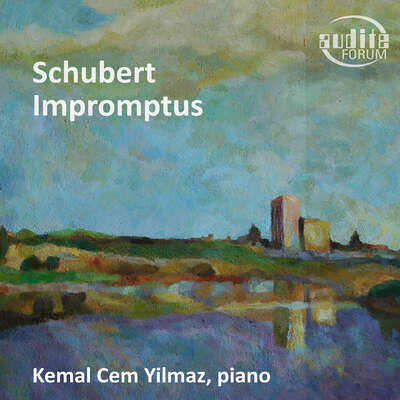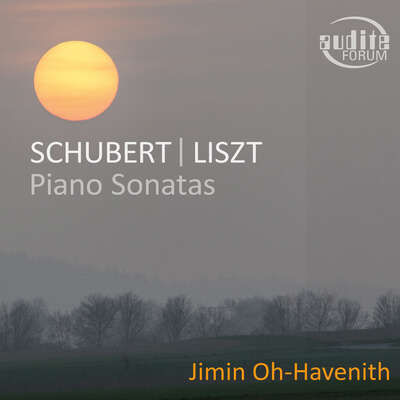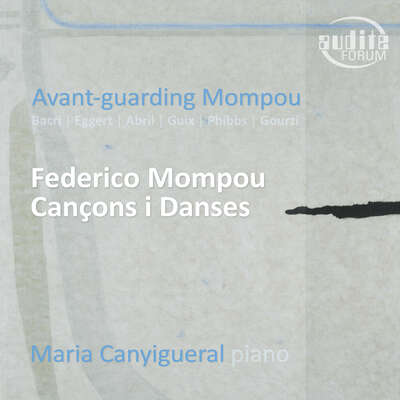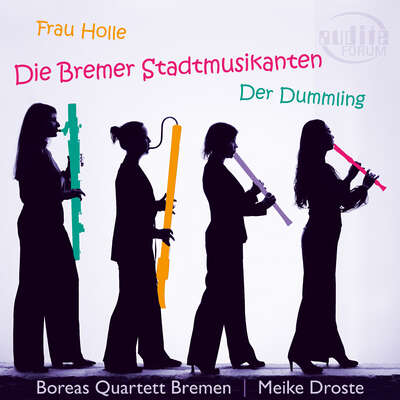
Auto-Rip
Béla Bartók’s Sonata for Solo Violin and Eugène Ysaÿe’s Sonatas Op. 27 are the most significant works for solo violin after JS Bach. Both Bartók and Ysaÿe continually refer back to the great model whilst preserving their originality. Prokofiev wrote his Solo Sonata Op. 115 for ambitious violin students; short and crisp, with class and spirit.more
"Ihre [Franziska Pietschs] aktuelle CD zeugt von stilistischer Treffsicherheit und manueller Brillanz." (Spiegel Online)
Details
| Works for Solo Violin: Bartók - Prokofiev - Ysaÿe | |
| article number: | 97.758 |
|---|---|
| EAN barcode: | 4022143977588 |
| price group: | BCA |
| release date: | 2. November 2018 |
| total time: | 64 min. |
Bonus Material
Informationen
Landmarks for Solo Violin
Franziska Pietsch's recent recording of the Prokofiev Violin Concertos with large-scale orchestra is followed seemingly by the opposite: works for solo violin. What appears, at first sight, to be a contrast is in fact a logical continuation of her extensive discography, even an enhancement: whilst in her previous releases, Pietsch demonstrated her expressive range and intensive approach both as a brilliant soloist and as an eloquent chamber musician, she now faces the greatest possible reduction, namely a solo recital. This limitation demands incredible presence, power and intensity, for which Franziska Pietsch is predestined. From isolation, she draws depth and grounding; "less" becomes "more"; soleness transforms into greatness.
For her solo recital, she has put together an individual choice of compositions which have accompanied her from an early age and which, for her, represent significant personal and artistic experiences. Prokofiev, to whose works she feels a particular affinity, is also featured here.
Once again, Franziska Pietsch displays a compelling combination of technique and interpretation: her irrepressible creative force penetrates all technical challenges, never losing sight of her interpretation, every note forming part of her reading - a deeply personal recording of the solo sonatas by Bartók, Ysaÿe and Prokofiev.
Bartók's solo sonata, written for Yehudi Menuhin in 1944, and the six sonatas Op. 27 by Ysaÿe are amongst the most prominent twentieth century compositions for violin. Bach, the great paragon, is present in all these works. From Ysaÿe's cycle, Pietsch has chosen the particularly striking Sonatas Nos 2 and 3 which are dedicated respectively to the violinists Jacques Thibaud and George Enescu. As an "encore" she plays the solo sonata Op. 115 by Sergei Prokofiev which had been intended for ambitions violin students. Transcending its original purpose, however, this compact work is a small stroke of genius.
Forthcoming recording projects featuring Franziska Pietsch include the violin sonatas by Shostakovich and Strauss (pianist: Josu de Solaun) as well as string trios by Schnittke, Penderecki and Weinberg (Trio Lirico).
Reviews
Image Hifi | 4/2019 | Heinz Gelking | July 1, 2019 Nicht nur Beruhigungspillen
[Franziska Pietsch] spielt die Sonate mit großer Geste, betont die Kontraste zwischen den Sätzen, ihr Ton ist herb und warm und groß, oft belebt von sattem Vibrato. Eine große Interpretation, die sich das Werk ganz zu eigen macht und das Widerständige, den Überlebenswillen betont.Mehr lesen
Süddeutsche Zeitung | Magazin Heft 26/2019 27. Juni 2019 | Carolin Pirich | June 27, 2019
GEGEN DEN STRICH
Als sie jung war, blockierte die DDR ihre Karriere. Jetzt stößt sie an die Grenzen der Musikbranche. Aber Grenzen sind ihre Spezialität: die erstaunliche Geschichte der Ausnahmegeigerin Franziska Pietsch
Sie fragt: Vielleicht möchten Sie mich in Aktion sehen? Man hätte dannMehr lesen
Fanfare | April 2019 | Huntley Dent | April 10, 2019
The blurb for this new recital from the estimable German violinist Franziska Pietsch says that the solo violin sonatas by Bartók and Ysaÿe were theMehr lesen
The first recording of the Bartók to come my way as a reviewer (in Fanfare 38:3) was by the superb Hungarian violinist Barnabás Kelemen on Hungaroton. He captures every facet of a rich, dense, extremely varied score. Comparing the piece with the two violin-and-piano sonatas, I wrote, “Perhaps the most difficult is the Sonata for Solo Violin commissioned by Yehudi Menuhin in 1944. The dying Bartók set himself the challenge of updating Bach in an uncompromising modernist idiom. The entry point here is formal, because we get a Bach-like Chaconne and Fuga in the first two movements, followed by a slow Melodia and a virtuosic Presto finale.”
Some performers, notably Christian Tetzlaff, smooth out the sonata’s aggressiveness, while others, like Vilde Frang, go for broke. Either way, the listener has to brace himself. Bartók employs the violin’s capacity to scrape, scratch, and wail more often than its capacity for song. Pietsch vies with Frang’s take-no-prisoners approach, underlining the work’s tonal extremes to an abrasive degree, risking more screech and scratch than I am comfortable with. Musically, however, she lacks Tetzlaff’s wonderful ability to give us a sense of wholeness in Bartók’s conception—the music shouldn’t be all noise and chaos. I also admire how Tetzlaff adds warmth to the lyric passages that crop up here and there, so despite her obvious skill and commitment, Pietsch’s reading wouldn’t be among my top choices. It should appeal, however, to anyone who wants an explosive performance of an astonishing work.
I admired Pietsch’s recording of the two Prokofiev Violin Concertos and the two sonatas with piano. She’s equally sympathetic in his late Solo Violin Sonata in D from 1947. By then Prokofiev’s inspiration was declining along with his health, but the solo sonata is agreeably tuneful, nimble, and upbeat. The work was commissioned by the Soviet music system as a teaching piece, so it is not technically very difficult. It was originally designed to be played by an ensemble of talented students rather than as a solo work. Pietsch’s reading is less pointed and intense than, say, Viktoria Mullova’s (Onyx), but it doesn’t suffer by comparison, being lyrical and appealing in its own right.
Ysaÿe’s Six Solo Violin Sonatas, gathered as his op. 27 in 1923, are beloved by virtuosos, giving them scope for brilliance and Romanticism to the utmost. In the second sonata of the group, dedicated to Jacques Thibaud, the “obsession” of the subtitle refers to Thibaud’s love of Bach and his habit of including the opening Preludio of Partita No. 3 in his morning practice sessions. Just as obsessive, however, is the contrasting use of the Gregorian Dies irae that captured the ear of many composers, most notably Liszt and Rachmaninoff. The juxtaposition of the two borrowings is incongruous but quite entertaining.
In the last issue Robert Maxham was enthusiastic about a performance from Maïté Louis (Continuo), who highlights the stark contrasts in Ysaÿe’s quotations. She maintains a beautiful, consistent tone as well and focuses on Romantic expression to an enticing degree. I’d say that Pietsch goes one better in expressing both the moods and contrasts in the piece. She has an air of personal involvement that’s captivating. The combination of excitement and presence makes this a memorable reading in all four movements, whether Ysaÿe is being misterioso or theatrical.
The program ends with Ysaÿe’s Sonata No. 3, “Ballade,” dedicated to Georges Enescu. Its single movement is in two sections, the first being lyrical and passionate, with almost continuous double- and triple-stops, the second, marked con bravura, moving into brilliant passagework without letting up on the double-stops. Pietsch gives an account as charismatic and captivating as in the previous sonata, which makes the Ysaÿe portion of the disc very compelling.
There’s always something of absorbing value in every release I’ve heard from this artist, and even if Pietsch’s Bartók frayed my nerves, that’s a personal reaction. On every other count this disc, which has excellent recorded sound, is strongly recommended.
Das Orchester | 4/2019 | Stefan Drees | April 1, 2019 | source: https://dasorche...
Die Orientierung an Formensprache und Ausdrucksvielfalt von JohannMehr lesen
www.qobuz.com | 18.03.2019 | SM | March 18, 2019 | source: https://www.qobu...
Wer meint, dass die Solovioline des 20. Jahrhunderts etwas schwierig anzuhören ist, sollte sich die feurigen und klangvollen Interpretationen von Pietsch anhören: ein ganzes Orchester auf einer einzigen Geige.Mehr lesen
Scherzo | 01.03.2019 | Pierre Elie Mamou | March 1, 2019
No nos dejemos engañar por la portada y su estética 'muro de Berlín'; unMehr lesen
American Record Guide | March/April 2019 | MAGIL | March 1, 2019
This is the fourth recording by German violinist Franziska Pietsch that I have had the pleasure to review. The earlier ones were the Grieg ViolinMehr lesen
My excitement turned to disappointment when I listened. I noticed that she wasn’t able to sustain the long lines of the Franck Sonata, and here she fails to elucidate the architecture of the Bartok. It is a very classical work in its emphasis on form, and she doesn’t make the work’s structure her first priority, opting instead to use varying tone colors in an attempt to give the piece episodic interest. This does not do the piece justice, in spite of the fact that Bartok was a great colorist, especially in his writing for strings. It fragments the work. Robert Mann’s recording (J/A 2003) is the most effective at making the form of the piece plain, and Pietsch and everyone else would do well to listen to it. On top of this, she decided not to play Bartok’s original quarter tones in the finale, which I believe ruins the buzzing house fly-like character of those passages.
I was surprised to hear Pietsch failing to bring out the simple lyricism of the Prokofieff. Again, her interpretation is episodic and fails to knit these three brief movements together. I expected that she would finally feel sympathy for the two Ysaye sonatas; they are the most volatile and episodic works here and demand a broad range of moods and colors from the performer. Again, she is more interested in surface effects than in getting to the heart of the music, especially in the deeply felt Sonata 2, which is a character portrait of the great French violinist Jacques Thibaud.
These are the weakest performances I have heard from her. She relies on her personality instead of her intellect to sustain the music, but it can’t. Great music must be met on its own terms and cannot be reduced to a medium for the display of virtuosity and temperament. I had always found Pietsch’s manner very appealing, but it hinders rather than helps these performances. The violin was made in 1751 by the Milanese violin maker Carlo Antonio Testore.
Fono Forum | Februar 2019 | Martin Demmler | February 1, 2019
Es ist mutig, ein Album ausschließlich mit Sonaten für Violine solo vorzulegen, stehen diese Werke doch zumeist ein wenig im Schatten derMehr lesen
Béla Bartóks Sonate für Violine solo gehört unbestritten zu den größten Meisterwerken der Literatur für dieses Instrument. Entstanden 1944 im New Yorker Exil für Yehudi Menuhin, verweist das Werk bereits in seiner Anlage mit einer großen Chaconne als Kopfsatz, gefolgt von einer Fuge, auf die Sonaten für Solo-Violine Johann Sebastian Bachs. Im ersten Satz wirkt die Interpretation Pietschs sehr expressiv, mitunter sogar aggressiv und mit großen dynamischen Kontrasten. Dabei gelingen ihr vor allem die polyfonen Passagen äußerst eindrucksvoll, während die lyrischen Abschnitte manchmal etwas unterkühlt wirken. Kraftvoll und emotional packend dagegen ihre Version der Fuge, zart und einfühlsam das zentrale liedhaft-melancholische Adagio.
Ohne diese Bedeutungstiefe kommt die Solosonate von Sergej Prokofjew daher. Das liegt vermutlich daran, dass sie ursprünglich als Übungsstück für Geigenstudenten gedacht war. Es ist ein heiteres, unkompliziertes Werk. Man hört Franziska Pietsch die Freude an, mit der sie sich dieser Musik annimmt. Da wird jede melodische Phrase ausgekostet, jeder kompositorische Einfall zelebriert. Sätze aus den Solo-Sonaten Eugène Ysaÿes sind heute meist nur noch als Zugaben zu hören. Dass sich eine intensivere Beschäftigung mit diesen Werken lohnt, stellt Pietsch hier eindrucksvoll unter Beweis.
http://klassiker.welt.de | 20. Dezember 2018 | Manuel Brug | December 20, 2018 | source: http://klassiker... Brugs Beste: Nummer 20 – Franziska Pietsch gibt allein ihrer Geige eine starke, reife, ungefügte Stimme
Das Salonhafte, Schillernde und das trotzig sich Aufbäumende, Franziska Pietsch beherrscht beides, letzteres scheint ihr näher. Sie traut sich das und hält es mit emotionaler Kraft durch. Musik als Gefäß der Wahrheit, in das sie ihr Sein gießt, ehrlich, ohne Manier, direkt, aufmerksam. Die Unmittelbarkeit ihre Gesten springt einen förmlich an.Mehr lesen
WDR 3 | TonArt | 10.12.2018 | Wibke Gerking | December 10, 2018 | source: https://www1.wdr... BROADCAST
Die Solosonate von Béla Bartók scheint Franziska Pietsch wie auf den Leib geschrieben. Wenn sie spielt, scheint ihre ganze Seele in der Musik zu liegen. Es ist eine radikale, extreme Interpretation, die sich eine künstlerische Freiheit nimmt, die auf einer tiefen Durchdringung des Werks beruht. [...] Franziska Pietsch ist eine intensive Geigerpersönlichkeit; entsprechend intensiv ist das Musikerlebnis.Mehr lesen
www.pizzicato.lu | 06/12/2018 | Uwe Krusch | December 6, 2018 | source: https://www.pizz... Auch beim Solorepertoire wieder überzeugend
Wann immer Franziska Pietsch eine neue CD vorlegt, sei es als Solistin mit Orchester, mit ihren Streicherkolleginnen im ‘Trio Lirico’, bei SonatenMehr lesen
Die Geigerin, deren Lebenslauf einen Bruch durch die politischen und dadurch ausgelösten familiären Umstände in der DDR hat, nimmt sich die Solowerke der beiden Komponisten in der Nachfolge der Kompositionen für die Violine solo von Johann Sebastian Bach vor, also Bartok und Ysaÿe. Als Brücke zwischen beiden Komponisten hat sie die Solosonate von Sergei Prokofiev gesetzt.
Wiederum findet sie auf der Basis ihrer technischen Meisterschaft einen persönlichen, die emotionalen Tiefen der jeweiligen Kompositionen auslotenden Zugang. Man mag vermuten, dass die erzwungene Unterbrechung der Entwicklung in der Jugend anfänglich ein Schock war, dass sich aber aus dieser Zeit der Besinnung eine besondere Sicht auf die Welt, vor allem die der Musik ergeben hat, die darauf Einfluss hat, dass ihre Interpretationen virtuoses Äußeres beiseiteschieben und sich ganz dem Zugang zur Musik widmen.
Violinist Franziska Pietsch’s account of solo works by Bartok, Ysaÿe, and Prokofiev is technically masterful, and very personal in its emotional depth.
Spiegel online
| Sonntag, 02.12.2018 | Werner Theurich | December 2, 2018 | source: http://www.spieg...
Violinen: Bartók würde sich wundern
Gegen die Konventionen und voller Gegensätze: Die Violinistinnen Franziska Pietsch und Vilde Frang widmen sich virtuos der Musik von Béla Bartók
Ihre [Franziska Pietschs] aktuelle CD zeugt von stilistischer Treffsicherheit und manueller Brillanz.Mehr lesen
Gramophone | December 2018 | Rob Cowan | December 1, 2018
Franziska Pietsch truly takes ownership of Bartók’s Solo Sonata. Her interpretation is prompted by the idea of his ‘explosive seriousness’, aMehr lesen
It’s fair to say that Bartók’s Sonata is the principal draw here but the second of Ysaÿe’s Solo Sonatas (dedicated to the great French violinist Jacques Thibaud) is also a work to reckon with, its opening ‘Obsession’ toying with Bach’s E major Prelude (Solo Partita No 3) while ghosting the ‘Dies irae’ chant, which dominates the rest of the piece. Again the cut and thrust of Pietsch’s playing makes a big impression, while the Bachian axis is nearly as evident in the single-movement Third Sonata, dedicated to that pre-eminent Bachian Georges Enescu. Here passion takes the upper hand and Pietsch never stints in that respect, nor in her masterful handling of chords.
Perhaps the lightest work on the programme is Prokofiev’s Solo Sonata which, as Norbert Hornig tells us in his useful booklet note, was composed in 1947 as an exercise in unison-playing for violin students. Of especial note is the folky third movement, where Pietsch focuses the spirit to perfection. Audite’s sound quality is extremely realistic so if the programme appeals, I wouldn’t hesitate. If it’s just the Bartók Sonata in digital sound you’re after then Pietsch is up there with Kelemen (Hungaroton, 5/13) and Ehnes (Chandos, 1/13), maybe even marginally more outspoken than either.
Die Zeit | N° 48 - 22. November 2018 | Holger Noltze | November 22, 2018 | source: https://www.zeit... Spielen, um zu überleben
Die Geigerin Franziska Pietsch wuchs in der DDR auf und lernte im Westen, was Freiheit in der Musik bedeutet. [...] „Die Möglichkeit, mit der Welt eins zu sein. Für einen Augenblick absolut."<br /> Mehr lesen
www.opusklassiek.nl | november 2018 | Aart van der Wal | November 14, 2018 | source: https://www.opus...
Ihr [Franziska Pietschs] Spiel offenbart wieder Musik, die durch Abgründe geht: Sie sucht ständig nach ihren Ausdrucksgrenzen, ohne über das Gechriebene hinauszugehen. Es ist eine besondere Mischung aus Rebellion und Melancholie, die sich abwechselnd zynisch, spöttisch und lyrisch, weitreichend oder sehr intim offenbart.Mehr lesen
